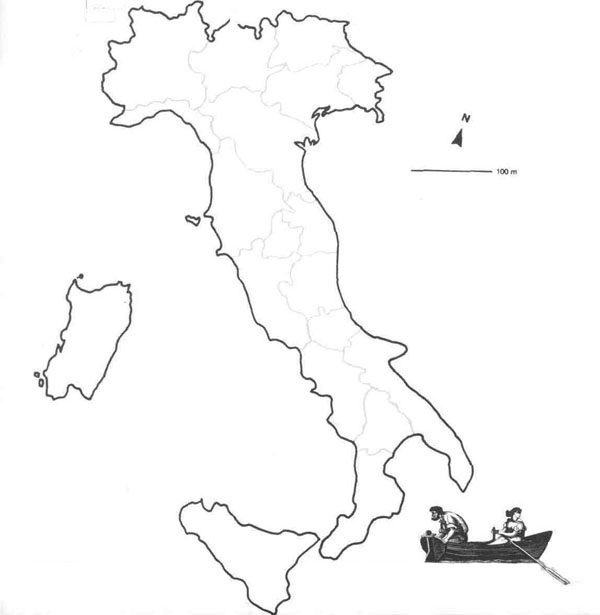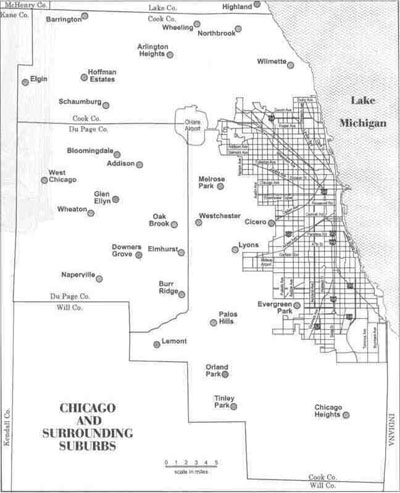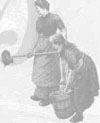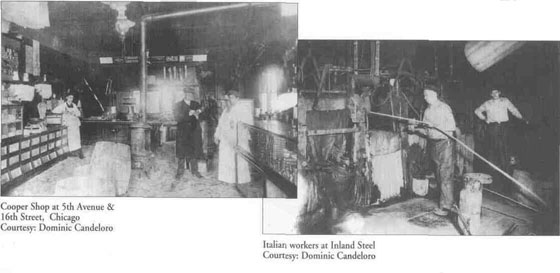 |
Home | Search | Browse | About IPO | Staff | Links |
 |
Home | Search | Browse | About IPO | Staff | Links |
|
Louis J. Broccolo
Overview
Main Ideas
Connection with the Curriculum
Teaching Level
Materials for Each Student
• A copy of the narrative portion of the article
Objectives for Each Student
• Explore the history of Italian immigrants and their descendants in Chicago
41
that of his or her ethnic group as a whole, as it applies to the Chicago area, and then into the larger pattern of American history
The activities range from easy to more difficult, and can be adapted by the teacher to fit different ability levels.
Opening the Lesson
The first and second handouts have the students using factual material from the article to locate the origins of Chicago's Italians and where they are located in the Chicago area. Show the movie "The Immigrant Experience: The Long, Long Journey" (Learning Coproration Of America, $59.00. Contact Social Studies School Service,10200 Jefferson Blvd., P. 0. Box 802, Culver City, CA 90232-0802, Phone: 1-800-421-4226). It is a wonderful thirty-minute movie about a Polish immigrant family in the early-twentieth century, and it can be used to show how the immigrant experience was very similar among many groups. Parts of "The Godfather - Part II" can be used, but edit carefully. The scenes showing Vito Corleone coming to Ellis Island as a boy and those showing the feste in New York's Little Italy are particularly good. Be sure to show only those parts. After the film the students can complete and then discuss Activities 3 and 4 with general questions on immigration and specific ones concerning the movie. They will need to have read some sources on immigration, possibly from their textbooks. Activity 5 asks for more specific information from the article, while Activity 6 also asks the students to draw some conclusions; this should lead to some interesting discussions. Activity 7 is the culminating activity where the students as historians get to put what they have learned to use and pull it all together as they complete a family history.
Developing the Lesson
• Allow students either class time or homework time to complete activities.
Concluding the Lesson
• Have the students write one or two paragraphs describing what they learned from all of this, particularly the family history project. Extending the Lesson
• Students could make displays using photographs, documents, etc. to show some of their family history. Explain to them how to protect any original and/or valuable "things" they might use.
Assessing the Lesson
• Discuss with the students how history is made, no matter how big the topic or issue, by individual people just like themselves. They should have a better understanding of that after seeing how their own families and ethnic groups contributed to the history of Chicago and Illinois, and in turn to the history of the United States. To paraphrase one the characters in the recent film, "Amistad", "We are what we were." 42
The article mentions a number of cities and/or regions in Italy as the origins of many of Chicago's Italians. Locate and label the cities listed. Color the region as directed.

43
The article lists a number of areas in Chicago and the suburbs where Italians settled or live now. Label the area or suburb (using the numbers) and then shade it in lightly with a pen or pencil.
Match the Italian church to the area or suburb (using the numbers).
Assumption ___

44
45
View the movie "The Immigrant Experience: The Long, Long Journey" with the class.

46
Match the person on the left with the description on the right.
47
Another book of interest here is Lisi Cipriani, Selected Directory of the Italians in Chicago (Chicago, 1929). Although it is harder to get (the Newberry Library has a copy), it is a fascinating short market guide listing 4,500 firms, stores, and professional men.

48
Now it is your chance to be the historian. Hopefully, this project will make the study of immigration more exciting and meaningful. As you gain a greater understanding of your own family's history and how that history has shaped and influenced you, you will also develop a greater appreciation for history in general. The project will also give you the opportunity to use a wide variety of sources, both primary and secondary. You will actually be the historian. Since this is part of your study on immigration, you should have background material from your class discussions, readings, etc. However, there are some key questions you need to ask before you begin.
What do I already know about my family history?Specifics of this assignment: • Make a chart showing your family genealogy. Include name, birth date, place of birth, when married, date of death, place of death. Go as far back in time as you can. • Complete the questionnaire with one or more relatives. • Complete general reading on your ethnic group in Chicago. • Write a five-page typed paper describing your family's history or some aspect of it. For example, compare and contrast your great-grandfather, grandfather, and father with respect to education, occupation, etc. Compare and contrast your mother's family with your father's family. Why did they come to America? Through out the paper you should compare and contrast your family with your ethnic group in Chicago (or the Chicago area). Does your family fit in with the general trends of your particular ethnic group? Integrate the general history of your ethnic group with your family history. Analyze what is going on; put things in perspective. This assignment is not a family genealogy. Although a family genealogy can be part of this, it is no? the main focus. Do not dwell on who married whom, for example. Certainly, we do want details, facts. However, we want to learn something of the lifestyle of your family: where they lived; what they did for a living; changes in residences. Sources to investigate: • Photo albums; family Bibles; letters; birth, baptismal, marriage, and death certificates; passports; immigration and naturalization papers; old bills; check stubs; wills; and court records. . • Oral interviews are another outstanding source, but be careful! The final paper must include a bibliography of at least five sources. Oral interviews may be used along with other more standard works. Encyclopedias are not to be included. Good luck! Two excellent books will help aid in your research on ethnic groups: Irving Cutler, Chicago: Metropolis of the Mid-Continent (3rd ed., Dubuque, Iowa: Kendall/Hunt Publishing Company, 1982) and Melvin G. Holli and Peter d'A Jones, Ethnic Chicago (Grand Rapids, Michigan: William B. Eerdmans Publishing Company, 1984 and later editions.). The bibliographies in these books are wonderful.
49
Name___________________________________ Date of Birth ___________________________________ From what country did they come? _______________________________________________________ _______________________________________________________________________________________ Town and Region:___________________Urban or rural area?_____________________________________ Population of town?_____________How old were they? ________________________________________ Who did they come with? (Parents, etc.) _____________________________________________________ Who migrated?_____________ What year? _______________________________________ Port of departure from Europe _______________________________________________________________ Port of arrival in U.S._______________________________ Name of Ship _____________________________ Why did they come to America? ______________________________________________________________ What was their attitude? ____________________________________________________________________ What problems, etc., caused them to leave Europe? ______________________________________________ What did they expect to find? _________________________________________________________________ What was their "dream"?_____________________________________________________________________ Did they intend to stay permanently or were they planning to go back?_______________________________ Did they go back?___________________When?________________________________________________ Why did they return the second time?________________________________________________ Why did they come to Chicago (as opposed to staying out East?)______________________________ Did they know anyone here in advance? Who? _______________________________________________ Where in Chicago did they live? ________________________________________________ Did they change residences once they settled in Chicago? __________________________________ To what parish did they belong? ________________________________________________ What was their attitude toward religion and the church? ___________________________________ Did they choose to live with other people from their same village or region? ____________________ OCCUPATION What was their occupation in Europe? ________________________________________________ How were they trained for their occupation in both countries? ________________________________ What education did they have in Europe?______________________________________________ in U.S.? ________________________________________________ SPOUSE How did they meet their spouse? ________________________________________________ ____________________________________________________________________________ Was marriage arranged?_________ Did they know spouse before they came to America?_________________ When did spouse arrive?_________ How old when they married?__________________________________ 50
Information on his/her spouse, family, etc. Name of Spouse_____________________________Date of Birth ______________________ Town and Region ________________________________________________ Year they or family came to America ________________________________________________ Additional Information ________________________________________________ What was their attitude toward other ethnic groups they encountered in America? _______________________________________________________________________________ _______________________________________________________________________________ What was their feeling toward their children (second generation) marrying out of their ethnic group? _________ ________________________________________________________________________________ Did they speak English before coming to U.S.? What language was spoken as the principal language inthe home? _______________________________________________________________________ Did both parents speak English?_____________________ If not, why not? _______________________ Could children (second generation) speak the native language?___________________________________ Could the parents write their native language?____________________ Could they write English after learning to speak it? ______________________ Where were the children (second generation) sent to school? _________________________________________ What was the attitude of the parent toward education? ________________________________________________ How did they acquire property (land, residences, etc.)?________________________________________________ When?____________________ Briefly describe their attitude toward their native country. ______________________________________________________________________________________________ ______________________________________________________________________________________________ Were they patriotic toward their native country? ________________________________________________ Did they consider themselves Europeans or Americans?________________________________________________ When did this transition take place?________________________________________________ When did they become citizens? ________________________________________________ Did they usually vote? ________________________________________________ Did they eventually feel that their dreams had come true? ________________________________________________ Did they believe they were truly better off in America compared to Europe? Why?_________________________ _____________________________________________________________________________________________ How did their attitudes change forty years after they came here? __________________________________________ Add any additional information you feel may be helpful. ________________________________________________ ______________________________________________________________________________________________ _______________________________________________________________________________________________ Click Here to return to the Article
51
|
|
|